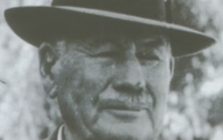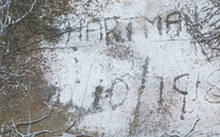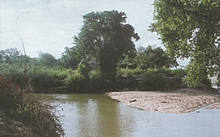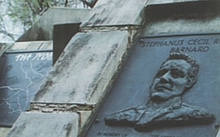Remembering Bvekenya
Love it or hate it, but South Africa’s most notorious ivory poacher left a footprint that’s worth preserving and his son is busy doing just that...
By Shaun Smillie





Deep in thick bush, close to Crooks corner at the far north-eastern corner of the Kruger National Park, lies the grave of South Africa’s most notorious ivory poacher, Stephanus Cecil Rutgert Barnard, better known by his Shangane nickname of Bvekenya (‘the one who swaggers as he walks’). Anyone familiar with TV Bulpin’s book, The Ivory Trail, would immediately argue that Bvekenya is buried on the farm Vlakplaas near Geysdorp in the North West Province. And so he is. The crooks Corner grave, which Bulpin clearly knew nothing about, is empty. Bvekenya’s son, Izak, explains how it came about. “My father was once so sick with malaria hat the Shanganes thought he was going to die, so they dug the grave for him. When I visited the site with my father in 1952, it was still two feet deep”. The grave is just one of several sites that Izak, his daughter Lientjie, niece Hester, and nephew Fanie recently went to Crooks corner to rediscover. They were on a mission to locate and, with the help of GPS handset, pinpoint and record each of the places where Bvekenya left his mark.
"We have to do it before it's too late," says Izak, "as many of the people who knew the locations are no longer around."
There are two other graves close to the unused one of Bvekenya. According to the concrete slabs covering them they belong to Hendrik Hartman and William Pye, who also feature in The Ivory Trail.
Hartman had an unusual death – he contracted sunstroke after becoming stuck up thorn tree. He had been cutting branches from the tree with which to create a sheep kraal, and failed to realize as he threw them to the ground that they’d prevented him from climbing down. Bvekenya later found and rescued him, but he died a day later. Pye died from influenza in 1918.
When Bvekenya arrived at Crooks Corner in 1910, it was true frontier territory
– a wild place that had acquired its name from the number of outlaws living there. Situated right where South Africa. Zimbabwe and Mozambique meet, it was an ideal place for fugitives from justice to skip over the border into another country. It’s said the outlaws survived on a diet of quinine and whisky while etching out a living by poaching ivory, blackbirding (illegally recruiting labour for the mines), and trading animal skins and sjamboks. The living was hard. If the animals didn’t get you, the malaria would or eventually the whisky.
Bvekenya quickly made a name for himself as an elephant poacher and was soon on the wanted lists of both the Portuguese and Zimbabwean (then Rhodesion) authorities. But as hard as these countries tried, they couldn’t catch him. “When my father first started hunting, he uses a .303 rifle with a shortened barrel,” says Izak. “To be effective he had to get close to his prey, sometimes within five meters or less. He told me stories of elephant actually falling on hunters because they were so close to them.”
According to Izak, Bvekenya wasn’t the ruthless poacher he was sometimes made out to be because he sought out older elephant that were already slowly starving to death. “He’d recognize them by their dung. If it was coarse, he’d know they had lost most of their teeth and couldn’t chew their food properly. These were the animals he concentrated on.” Over the years the bush has reclaimed most of the places mentioned in The Ivory Trail. Close to the graves of Hartman and Pye was Makhuleke village where several of Bvekenya’s friends lived, but next to nothing remains of it today. The only signs that people once lived there, are the scattered remains of a bicycle and the concrete floor of the Makhuleke store. A piece of an ox wagon that might have belonged to Bvekneya himself has also been found.
The store features strongly in The Ivory Trail. It was an important supply point and also a meeting place. People would travel long distances to it to stock up on everything from ammunition to gin, and to catch up on the progress of the ‘Great War’ (World War 1) in Europe – or to laugh at the latest attempted by the government to stamp its authority on Crooks Corner.
The store was owned by Alec Thompson and later managed by a Canadian Tomas ‘Buck’ Buchanan. Apart from the floor, two rows of mountain syringe tree, probably planted as a windbreak, mark its site on a hill overlooking the Limpopo River.
Towards the end of his stay at Crooks Corner, Bvekenya did a little blackbirding himself, but he also worked legally for the mines. During this time he built several roads and drifts in the area. The remain of one of the drifts can still be seen at Klopperfontien, while at Boabab Hill, between Punda Maria and Crooks Corner a road of his can be made out winding its way past the big tree that lends its name to the hill.
Bvekenya eventually left Crooks corner in November 1929. According to Bulpin, he gave up his nomadic hunting lifestyle after successfully tracking down a legendary elephant known as Dhlulamithi (taller than the trees). It was described as “the mightiest elephant in all the land”, and shooting it had become an obsession with the poacher. But when he finally got the tusker in his sights, he had a change of heart. And so he settled down and took up farming at Geysdorp. The only time he returned to Crooks Corner was in 1952 when he went there with Izak. “He wanted to lay the concrete slabs on the graves of Pye and Hartman.” Izak says. Bvekenya introduced Izak to Crooks Corner, showing him the places he’d frequented. They were even able to track down Buck Buchanan, who was living in a hut near Louis Moore mine, close to Giyani. “I believe he died a few years later,” says Izak.
Bvekenya died in his bed on his farm on June 2, 1962, but his legacy continues through his son. A year and a day after his father’s death, Izak began taking safaris into the Kalahari. The safaris were unique for the time as customers did not come to hunt but to experience the area. Izak, in fact, pioneered ecotourism. He later set up Penduka Safaris, which still operates today. Like his father, Izak has also become a legend; particularly through the work he’s done wit the San in the Kalahari.
As for Dhlulamithi, the elephant that mended Bvekenya ways, nothing more is know.
According to Bulpin’s book Discovering South Africa, in 1967 an elephant that was thought to be him – was shot in Gona-Re-Zhou (ironically meaning ‘refuge of the elephant’) National Park in Zimbabwe. It yielded tusks amongst the largest ever recorded south of the Zambezi.
The actual location of Crooks Corner is on an island in the Limpopo, close to where the Luvuhu River flows into the Limpopo. There used to be a beacon on the island that marked the spot, but recent floods washed it away. Across from Crooks Corner is Ypie’s Island, named after Bvekenya’s favourite mule, which was marooned on the island for several weeks.
Bvekenya had his camp on the South African side of the Limpopo, near to the historic Ivory Trail that followed the river down to Sofala in Mozambique. Bvekenya knew this trail well, having traveled it on countless occasions with packs of donkeys laden with ivory to be sold at the port town.
Today Bvekenya would have difficulty recognizing the Limpopo. The once ‘great, green, grassy’ river is now a shadow of its former self. In winter it becomes a mere trickle, thanks to extensive irrigation on the South African side. In 1986, Izak erected a memorial to his father near the site of Makhuleke village. It reads: In memory of Bvekenya and his wild companions who followed the ivory trail.
"I dedicated it not only to my father, but also to all the men like him who lie buried somewhere in the bush and are long forgotten," says Izak.
The memorial erected by Izak Barnard
This also commemorated Bvekenya’s 100th Birthday